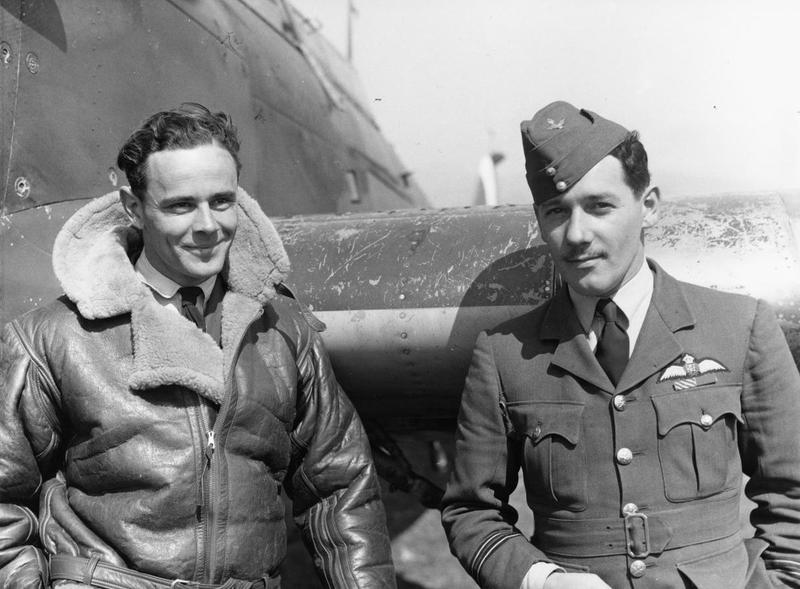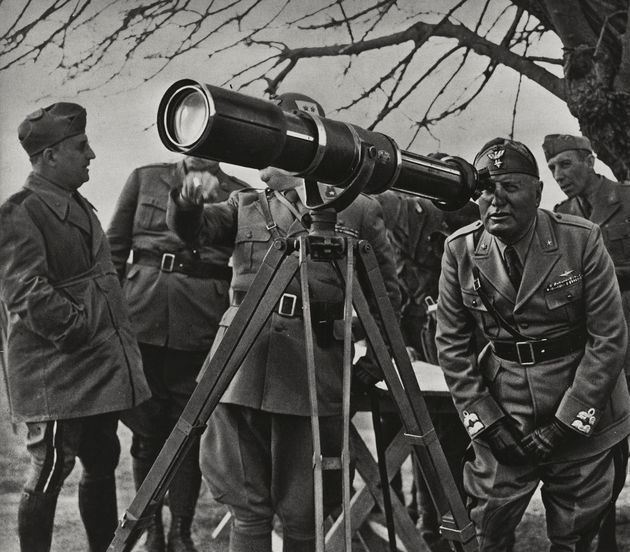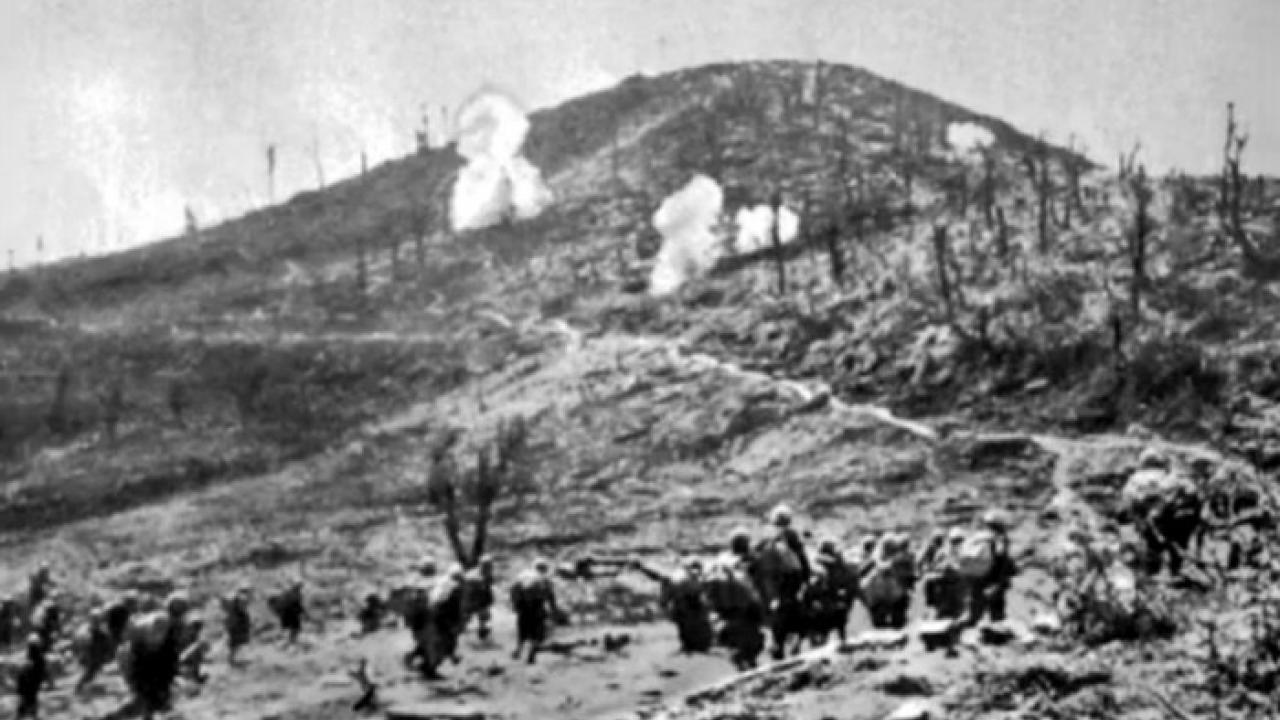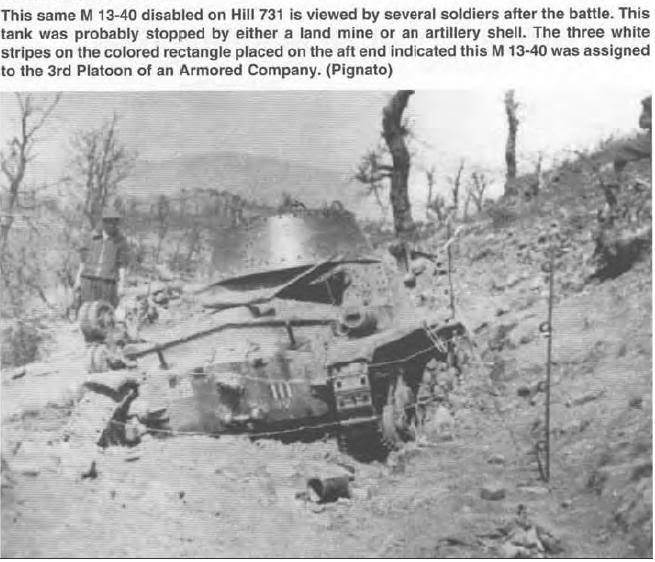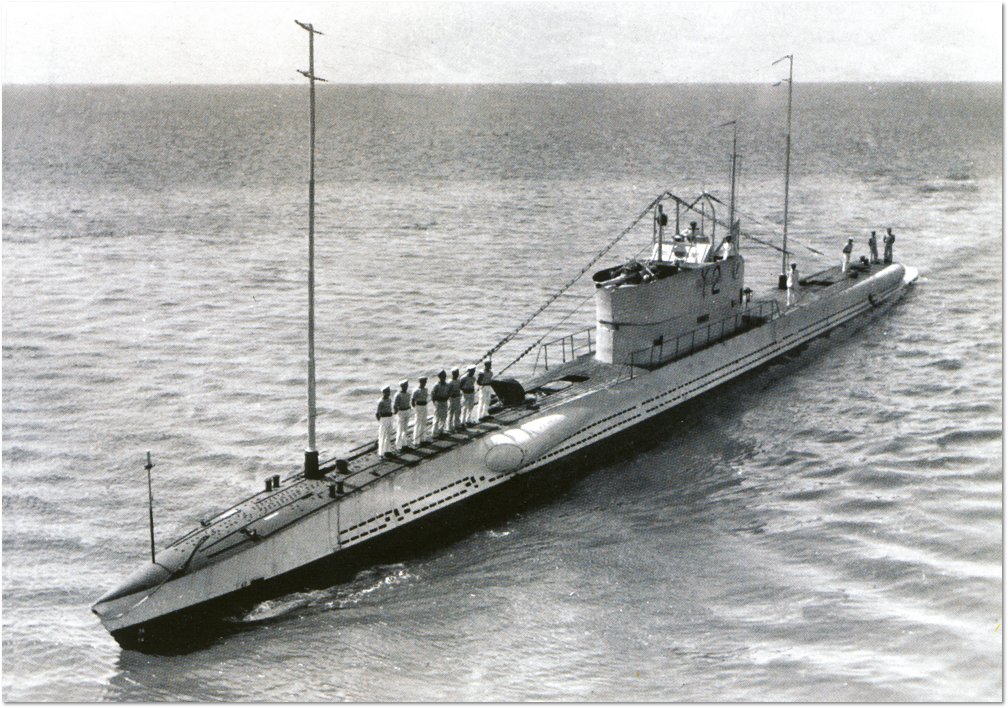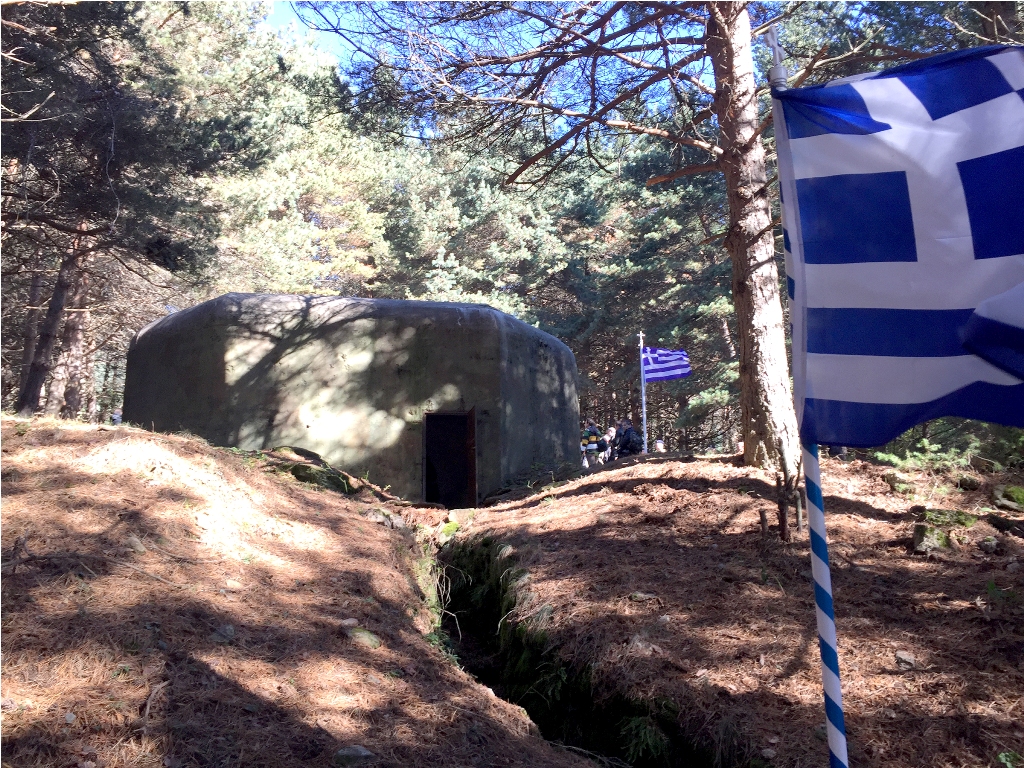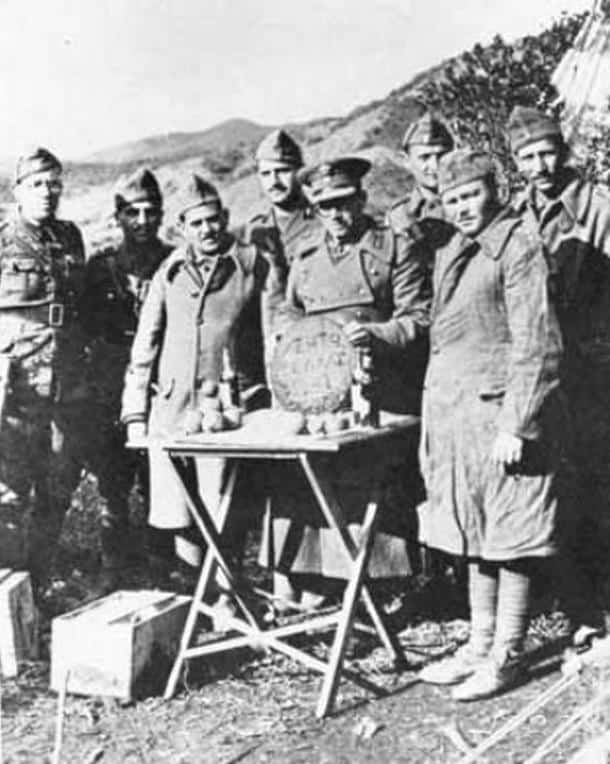Colored photograph of a New Zealander soldier in Egypt, immediately after the evacuation from Crete, holding a helmet (probably his own) having a bullet hole. June 1941.
November 1940. British Bren Carriers arrives in Crete (Chania) under the look of Greek soldiers and civilians. (AWM).

- Greek gun crew during firing against Italian positions on Albanian front.
Greek commemorative photo
- Greek soldiers photographed before leaving for the front.
January 1941. R.A.F ground personnel at the port of Piraeus,Greece.
Pat Pattle (left). Pattle is sometimes noted as being the highest-scoring British Commonwealth pilot of the war. If all claims made for him are correct, his total could have been more than 51. It can be stated that his final total was at least 40 and could exceed this number. Log-books and semi-official records suggest this figure, while personnel attached to his squadron suspect the figure to be closer to 60. A total of 26 of Pattle’s victims were Italian; 15 were downed with Gloster Gladiators, the rest with Hawker Hurricanes. He is considered to be the highest-scoring ace on both Gladiator and Hurricane (35 victories) fighters.
- Greek soldiers, some of them wounded, are photographed on the Albanian front.
Battle of Hill 731
The battle of Hill 731 was the climactic battle of the Greco – Italian war. It was dubbed “the Verdun of the Greco-Italian War” and “the new Thermopylae” due to the titanic struggle by both sides.
By January 11, 1941 (Capture of Klisura Pass), the Greek army stopped its offensive. Τhe Italian lines of supplies were shortened and improved, plus the Italians begun to reorganize. The Greeks, facing adverse weather conditions, supply difficulties and frostbites (losses from frostbites were larger than the combat losses) had to stop, to reorganize and replace lost men and materiel. After the death of prime minister/dictator Metaxas in January 29, 1941, king George II assumed full executive powers (despite the British suggestions to restore democracy by raising a national unity government), and the armed forces were waiting the British reinforcements, mainly ammunitions, tanks, tankettes, anti-tank and anti-aircraft weaponry, as they were not a mechanized force.
On the other side, Mussolini, already knowing that the Germans were going to attack Greece from Bulgaria in late March – early April. was anxious to gain a victory before the German intervention, to save his prestige. New and fresh reinforcements in men and materiel tipped the numerical balance hugely in Italian favor. On January 26, the Italians attempted to recapture the Klisura Pass, (Battle of Trebeshina). In the middle of heavy snow and blizzards, the II Corps, reinforced by the III Corps and the fresh 5th “Cretan” Division, counter-attacked and advanced further deep in Italian positions, capturing, until February 17, Trebeshina ridge, Mali Spandarit, the village of Bubeshi and hills 717 and 731 (named by their height). Nevertheless, the 5th Division lost 5,776 men and became essentially a unit existent only in paper.
By the end of February, the Italians transported to Albania 10 new divisions, along with thousand tons of materiel (the Italians had already 15 divisions in Albania). Mussolini arrived on March 2, to lead the attack, named “Operation Primavera” (Spring) designed by general Ugo Cavallero. The objective of the attack was the capture of Ioannina. The aim was to attack in a 6 km wide front, to open a highway through the Greek II Corps, which was in charge of the Greek center since November, recapture Klisura Pass and Leskovik and re-enter Greece. The center and the focus of the Italian attack was Hill 731
The Greeks, observing the obvious Italian preparation, were digging trenches, creating five lines of defense. The defense was comprised by II Corps (17th, 5th, 1st, 15th, and 11th Divisions) with three regiments as reserve, and able to be reinforced by the 4th Division
Hill 731 was defended by the 2nd battalion, of the 5th regiment of the 1st Division of the II Corps. The regiment was comprised by men from the mountainous Thessaly (prefectures of Trikala and Karditsa), and the battalion commander was Major Dimitrios Kaslas from Volos, a veteran of the Greco-Turkish war.
In general, the Italians would attack with the VIII Army Corps (59th Cagliari , 38th Puglie , and 24th Pinerolo Divisions) and two elite Blackshirt battalions of the 26th Legion, XXV Army Corps’ 2nd Sforzesca Division, the 47th Bari , 51st Siena , and 7th Lupi di Toscana Divisions as a second echelon, and the Centauro and Piemonte Divisions as general reserves.
The battle
On March 8, Italian air-force commenced its bombardment (190 airplanes, including 70 bombers). On the first hours of March 9, Mussolini moved to the forward observatory position of Rehova, opposite Hill 731 and within the range of Greek artillery. No other WW2 leader found himself so close in battle. At 06:00, 300 Italian cannons started shelling the positions of the 1st Division (it was said that the cannons had a distance of only 1 meter between them). At 7:30 colonels Ketseas and Georgoulas telegrammed Kaslas for an update for Hill 731. Kaslas responded that the positions were firmly held. They telegraphed him back: “ You will defend your positions until the end! Fatherland and the Supreme Command demand to uphold the honor of your arms ”. Kaslas warned his soldiers that anyone trying to escape would be shot by him on the spot and issued this written order at 09:00: “ We will defend our positions until the last man. No man will move back. Encourage your fellow men and boost their morale. We are expecting a fervent enemy attack, that will be surely repulsed and crushed. The only possibility for the enemy to pass through here is for us to die on our positions. ”.
It is estimated that over 100.000 shells fell at a zone of 6 km in 2,5 hours. At 09:30, under artillery coverage, the Italian troops begun their advance, a battalion of Puglie division. The Italians didn’t expect any Greek survivors, but the Greeks were well covered. All that followed was a picture of WW1: Mass attacks against entrenched positions, defenders that expected the attackers to come close enough, machine guns that found easily their target against the multitude of attacking soldiers. Also, for the whole Operation Primavera, the Italians failed to damage the Greek artillery, which continued to provide support for the entrenched Greek defenders throughout the entire battle. At Day 1 the Italians captured Hill 717 (500 meters west of Hill 731), but the Greeks refused to counter-attack for it. Mussolini said to the chief of the Italian Airforce Francesco Pricolo: “ If an attack is not successful in the first 2-3 hours, it will never succeed. ”.
On day 2, after another artillery barrage, the Italians attempted to attack from the left the Hill 731, to encircle it, on 08:50. Closing to 100 meters, they raised white scarves to pretend that they were surrendering. For the first time in the battle, the defenders came out of their (almost destroyed) trenches to attack with fixed bayonets. At 11:45, 72nd regiment of Puglie division attacked, to be reduced after fire from 731, Trebeshina and Kiafe Luzit. Another attack was made at 18:00, blocked by rifle and artillery fire.
From this day on, the aggressive defense of the Greek units became a major characteristic of the Greek tactic. Covered by the smoke and the dust of the battle, they waited their enemies with fixed bayonets, out from their trenches. Also, the Greek casualties were rising. Many machine-gunners were killed, so ordinary soldiers were taking their place. Untrained with them, they burned their hands, and when the machine guns were turning red, they urinated them, to decrease their temperature.
At 04:30 of day 3, the Italians, under fog, attacked the southwestern side of the Hill 731. The 2nd battalion, helped by an auxiliary platoon, repelled the attack. The Italians, disorganized by the fog, were routed. The Greek 19th battalion of the 3rd regiment came to help the 5th regiment. Another attempt to encircle the defenders was made by two Blackshirt battalions under the fog, in a gorge from the left side, but at 09:00 the fog was dissolved and the defenders, monitoring them since the beginning of their maneuver, machine gunned them. New attack, under artillery coverage, was repelled after close combat on 10:45. The Italians, during the night, replaced the decimated Puglie division with Bari division. Mussolini asked Cavallero’s opinion about the first three days of battle. Cavallero said “mediocre”, and Mussolini responded: “Zero”.
At 00:45 of day 4, Italians commenced a strong attack under artillery coverage against Hills 731, 709, 710 and Bregu Rapit. The attackers, under the dark and the rain, reached Greek trenches, to be repulsed under close combat. While they were retreating, they were hit by the Greek artillery. New attack on 07:30, against 731, Bregu Rapit and Kiafe Luzit from the Italian 140th regiment was repulsed only after the Greeks counter-attacked with bayonets and grenades. During the night, the 5th regiment, which was at its limits (6 officers and 119 soldiers KIA, 8 officers and 425 soldiers injured, 1 officer and 27 soldiers MIA), left the front line, apart Major Kaslas, who remained for another 24 hours. On the Italian side, things looked grim, as the report of general Carlo Geloso, commander of the Eleventh Army noted that the operation was a failure. Mussolini insisted that the operation should continue: “ …We must continue the attack because, if we are ambandoning it, it is crystal clear that our cause is lost. The Greeks can create more unpleasant situations against us, like after our attack in Klisura Pass (the defeat at Trebeshina in February) …Germany will attack in early April and will inform us 6 days beforehand… It is necessary, before the German intervention, to have a military success, or else the Germans will be boasting, that the Greeks retreated because of them and they will be right. We have 19 days. ”
At 13:30 of day 5, an Italian bombardment at the entire front annihilated the 9th company of the 19th battalion, which stood at the top of the 731. 2 hours later, the 140th regiment of Bari division attacked again, under artillery cover, against 731 and Bregu Rapit. Despite the Greek massive fire, the brave and persistent Italians kept attacking, and the Greeks came out of their trenches with fixed bayonets. During the close one-on-one combat, it seemed that the Italians were finally going to take 731. During the most critical moment, the small auxiliary unit of the battalion attacked, while the Greek artillery prevented the Italians to reinforce the 140th. When the Greek soldiers saw the company’s leader, second lieutenant Tzomalos killed, they viciously counter-attacked, finally throwing out their enemy from the hilltop. Some Italians faked that they were surrendering, only to throw their grenades hidden in their sleeves. In result, this was the first time that the Greek soldiers took no prisoners. Two more Italian attacks, at 18:00 from a battalion, against 731, without artillery support, and at 19:30, against 731 and Bregu Rapit, were easily repulsed.
At 10:00 of day 6, the Italians launched their largest attack, against 731, Bregu Rapit and later against Kiafe Luzit, from the 139th regiment of Bari division. Under the cover of mortar fire, the Italians encircled 731 and reached the hilltop. The Italian vanguard reported the capture of the hill. Captain Koutridis, commander of the 19th battalion, after securing cover from the Greek mountainous artillery, attacked with the auxiliary platoon of second lieutenant of the reserves Hatzikyriakos. It was a savage close combat, in which bayonets, rifle butts, rocks, hands and teeth were utilized as weapons. Hatzikyriakos was killed and Koutridis was injured. The struggle of Koutridis’ soldiers to take him and transport him to a field hospital, along with two new companies that arrived from the sides, led to another Italian retreat, at 12:30.
On 14:00, 300 artillery pieces of all calibers bombarded the hill, as if they aimed to pulverize it. An hour later, Italian infantry attacked with airforce cover, but they managed to reach only the first line of trenches. The Greeks captured many POW’s, light mortars and sub-machine guns. At 18:00, another attack of an Italian battalions, fell inside the first line of trenches.
On 13:15 of day 7, the Italians hit the hill with artillery. At 20:00, without artillery fire, four companies of the reinforced 139th regiment suddenly attacked. Despite the artillery, mortar, sub-machine, and machine-gun fire, the Italians seemed unstoppable. Concurrently, the Italians from Hill 717 utilized covering fire for the attack of the 139th and minutes later, Italian heavy artillery allowed the companies to come closer to the trenches. Ultimately, the Greek artillery annihilated the Italians on Hill 717, and a counterattack led by Lieutenant of the reserves Laurentiades (who was ultimately injured), kick the Italians out of 731.
It was obvious by then that Greeks were winning. The 8th day of the battle was the first that the Italians didn’t attack. After 3 days of peace, their climactic attack against Hill 731 started at 06:30 of March 19, with the heaviest bombardment of the battle. At 7:00, elements of Siena Division, i.e. 200 infantry soldiers, one M13/40 tank, strong artillery squads, and mortars of all calibers attacked. Behind them were 3 more M13/40 in reserve. One of them shot the side of the Hill and hit two Greek companies. Despite the Greek fire, the lack of anti-tank weapons allowed the tank to reach the hilltop, and to destroy the Greek machine-gun positions. The command of the Greek 19th regiment believed that the hill fell to the Italians, but a pocket on the hilltop, led by sergeant major Zikos, kept fighting. Second lieutenant of reserves Tzathas counterattacked with his auxiliary platoon, and his soldiers attacked with their grenades. The Italians were split in two and Lieutenant Laurentiades counterattacked with his own company, using Molotov cocktails. Nevertheless, the Italians were firmly holding their positions, covered by their tank. Second Lieutenant of the reserves Rountos brought a heavy machine-gun and hit the tank with penetrative bullets. The tank moved backwards and Tzathas with two other soldiers climbed on its tower and tried unsuccessfully to destroy it with grenades. In any case, two of the tank crew were mortally wounded from the machine gun and the tank fell at a trench. The rest three tanks in the Italian rear were neutralized by the Greek artillery.
The Italians were finally being encircled and the Greeks, seeing that the Italians killed all Greek POWs on the spot, were enraged. The battle turned really nasty, with fists, bayonets and shootings at point-blank range. Only half of the Italians escaped, the rest 100 were killed on the spot. It was over.
Mussolini left for Italy in the morning of March 21, saying: “ I’m leaving for Rome. I’m disgusted by this environment. We didn’t advance a single pace. I feel cheated. I deeply despise these people ” (his generals)
On March 22, an armistice of 6 hours was agreed, for the mutual collection of the bodies. An Italian priest, watching the corpses and the general situation of Hill 731, suffered a mental breakdown and kept shouting “ Terribile! Terribile! ”.
After artillery fire for the next 4 days, the Italians made two last infantry attacks in the evening of March 23. 18 failed attacks in total.
The Greek 1st Division had for the entire Operation Primavera 27 officers and 531 soldiers KIA, 59 officers and 2028 soldiers wounded. The Italians had 12.000 KIA. Cagliari Division lost her 2/5 of her force. Puglie Division was essentially destroyed. Mario Cervi in his book “The Hollow Legions” wrote (translation from a Greek excerpt): “ The blood price could be justified if the result was victorious. But 12.000 killed are a terrible price for an offensive move that did not moved forward from its starting point and was made only to satisfy Mussolini’s ambition ”.
The Hill lost 5 meters from its height due to the battle and became “Hill 726”
Aftermath
Mussolini was proven right. On April 6, the Germans attacked Greece from Bulgaria. They encircled Metaxas Line and they forced the numerically inadequate and disorganized British/ANZACs to retreat. Despite the orders of the king and the general staff, most Greek generals, surrendered. But, at their insistence, they surrendered to the Germans alone, and not the Italians “which have defeated in battle”. Only after the pressure of Mussolini to Hitler, they signed a second instrument of surrender to the Italians, but the latter faced ridicule, even by the Germans. As Wilhelm Keitel wrote: “ The quarrel over the troops’ victorious entry into Athens was a chapter to itself: Hitler wanted to do without a special parade, to avoid injuring Greek national pride. Mussolini, alas, insisted on a glorious entry into the city for his Italian troops. The Führer yielded to the Italian demand and together the German and Italian troops marched into Athens. This miserable spectacle, laid on by our gallant ally, must have produced some hollow laughter from the Greeks. ”
The Hill 731 (with a new height of 726 meters), became a “sacred zone” for the Italians. They erected a large memorial honoring their fallen soldiers. After WW2, Enver Hoxha destroyed it, and after the fall of communism in Albania, two modest monuments were raised by Greek and Italian citizens. Also, the battle is engraved upon the Tomb of the Unknown Soldier in Athens, upon with every other battle of WW2 that Greece participated.
Demetrios Kaslas, the hero of the battle, after the fall of Greece, returned to Volos. He joined the Republican/Right Wing Resistance organization EDES. After his capture from EAM/ELAS, the largest, pro-communist, resistance army in Greece, he accepted their proposal to join their ranks. He was made a colonel, commanding the 52nd regiment of XVI Division, where he fought with distinction in Central Greece and mountainous Thessaly. Finally, he fought in the Battle of Athens against the British in December 1944, after the liberation of Greece.
After the defeat of EAM and the beginning of the Greek Civil War, Major Kaslas (his rank of colonel in the Resistance wasn’t recognized by the Greek government), was branded as a dangerous communist, he was arrested, demoted to private and deported to various Aegean Islands (Serifos, Icaria, Santorini). At his own request, he was discharged as a lieutenant colonel on January 12, 1948 and he returned home. He made various jobs for living and broke any connection with his military past. He bitterly denied his earlier status to people who served under his orders and recognized him. He died from a heart attack on February 22, 1966 after he suffered a stroke. In 1985, after the recognition of EAM/ELAS as a Resistance organization in 1982, Kaslas was posthumously promoted to Brigadier General.
Reasons for the outcome of the battle and the Operation “Primavera” in general
- The Italian command concentrated its forces in a short space (6 km) of mountainous terrain. Thus, its numerical advantage was nullified, as it was forced to divide its troops.
- Persistence to a tactic that was proved ineffective, instead of following the strategic aims. Italian divisions were annihilated because the Italian command kept sending them against entrenched positions.
- Ineffective Italian Air-Force, which failed to neutralize Greek artillery. For the whole battle, the Greek artillery was constantly supporting the defensive positions of the army, either by hitting the attackers, or by preventing their enforcement.
- Aggressive Greek defense. The soldiers in the trenches kept coming out of them to pursue the Italians, as they were better trained in bayonet combat.
- Despite their unquestioned bravery, most Italian soldiers lacked any motive to attack Greece. On the contrary, the morale of the Greek soldiers, who viewed themselves as defenders of their country and their families, despite the hardships of the war, was never higher.
- Shortage of Italian professional field officers, especially to command battalions.
- The general Italian lack of ammunitions.
- Lack of coordination between Italian artillery and infantry. Many times, the infantry was forced to stop after 50-60 meters of advance, waiting for the artillery to adjust. Thus, they became sitting ducks.
Sources
- “Winter Operations – Italian attack of March”, Greek General Staff/Army History Directorate, Athens 1966.
- Lieutenant General Georgios Tzouvalas, “Hill 731, We”, Athens, 2007
- Terzakis, Angelos (1990). The Greek Epic: 1940 – 1941. Hellenic Army General Staff, 7th Staff Office.
- Constantine E. Avtzigiannis, The Epic of Hill 731, Athens 2007
- Panagiotis Mavrokefalos, Hristina Mavrokefalos, “The Italian Operation Primavera is crushed at Hill 731”, “Military History” magazine, Athens, March 2009.
- Collective, “ October 1940: The attack against Greece as Italians saw it ”, Athens 2008.
- “Time-Machine”, TV Show, "The Battle of Hill 731 ", by the Hellenic Broadcasting Corporation (ERT)
Greek troops during the Italian spring offensive
Hill 731 during the battle
Major Kaslas (in the middle) during the war
Topographical plan of Hill 731 and the surrounding areas
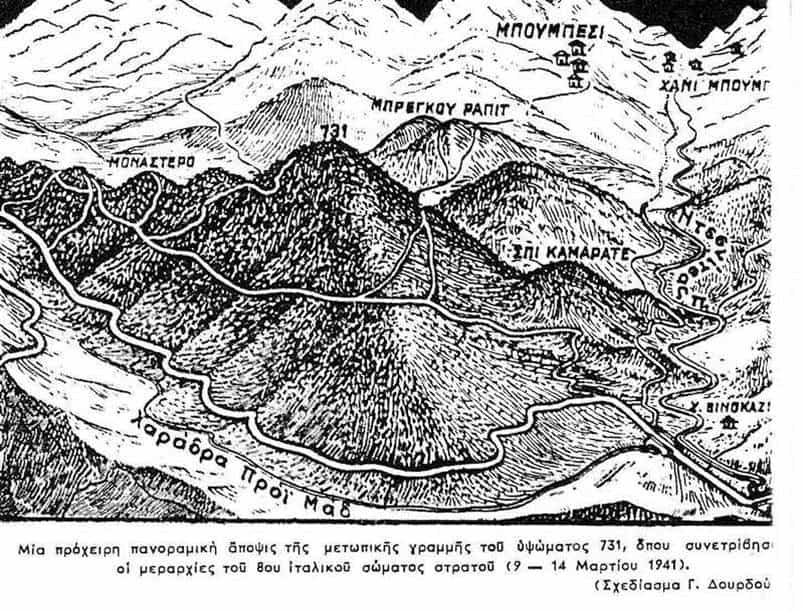
Italian officer two months after the battle on Hill 731

A first Italian memorial for the fallen of Hill 731, after the retreat of the Greek army during the German invasion

22-23 of December, 1940: The feats of submarine Papanikolis
Papanikolis was, indisputably, the most celebrated submarine in the history of the Greek Navy.
Papanikolis , together with her sister ship, Katsonis , formed the first class of Greek submarines ordered after the First World War. She was built at the Chantiers de la Loire shipyards between 1925–27, and commissioned into the Hellenic Navy on 21 December 1927. Its first captain was Cdr P. Vandoros. It was named after the Greek War of Independence hero, Dimitrios Papanikolis.
Greece was trying to update her navy according to her financial capabilities, but in any case, the Navy received the least money, as in the event of the war, it was calculated that the British Navy would support Greece. The country entered World War II with a navy consisting of 2 battleships, 1 armoured cruiser, 14 destroyers, and 6 submarines, a force obviously not comparable with the Italian Royal Navy.
Since a direct combat against the Italians was out of question, the mission of the Navy was to patrol the area near Dodecanese and the Ionian islands, but always inside Greek territorial waters, and to transport soldiers from the islands to the mainland.
The Greek government, wishing a naval success along with the victories in the Albanian front, for propaganda, ordered Papanikolis for its second mission (December 17 - December 27, 1940) to come out from the Greek territorial waters and patrol the Straits of Otrando to harass the Italian naval lines of reinforcements to Albania. Papanikolis’ captain was Lieutenant Commander Miltiades Iatridis, known as a daring and insubordinate officer, and his Executive Officer was Lieutenant Vasileios Arslanoglou, an Anatolian Greek born in Mersin, who was the strict keeper of rules in the submarine (he was killed in Malta, on February 27, 1942, during a Luftwaffe bombardment).
Οn 22 December 1940, Papanikolis sank the small Italian motor ship Antonietta, and, on the very next day, the 3,952-ton troop carrier Firenze near Sazan Island.
Despite the obvious inability of the Greek Navy to disrupt the Italian sea routes, the victories of Papanikolis were widely celebrated and became another morale boost for the rest of the War. Iatrides was immediately promoted to Commander and Arslanoglou to Lieutenant Commander.
After the Battle of Greece, Papanikolis managed to survive and took refuge to Alexandria along with the surviving Greek Navy, and continued the fight until 1945, when it was decomissioned. The submarine was sold for scrap, except its conning tower which was preserved and is on display in the Hellenic Maritime Museum at Piraeus. Two more submarines of the Greek Navy were named as “Papanikolis”, honoring the legacy of the legendary ship, an ex-US GUPPY-IIA boat, in service between 1972–1993, and a Type 214 submarine class, in service since 2010.
Commander Miltiades Iatrides, commander of Papanikolis
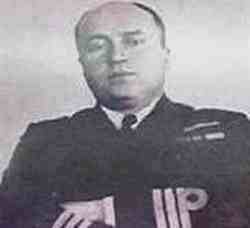
Vasileios Arslanoglou (1908-1942), named Commander after his death

An excerpt of Iatridis’ official report about Papanikolis feats
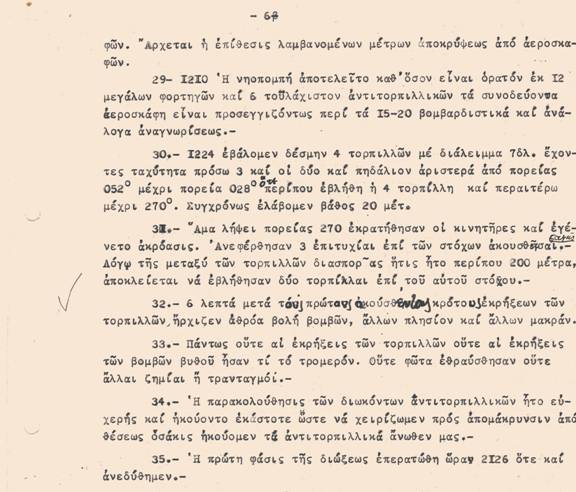
Papanikolis conning tower as it is today in the Hellenic Maritime Museum.

December 29, 1940: The fate of Proteus
The submarine Proteus (Y3) (of the Proteus Class of the Green Navy) was commissioned by the Greek government in France in 1927 along with three other similar submarines, Nireus, Glaucos, and Triton. Proteus was built between 1927–1929 at the Ateliers & Chantiers de la Loire shipyards in Nantes. The Greek flag was raised on August 31, 1929, and it joined the Greek Royal Navy under the code “Y3”.
The boat was 68.6 x 5.7 x 4.1 meters with a displacement of 790 tons (or 960 tons in diving) and was driven by two propellers. The propulsion system consisted of 2 Sulzer-type diesel engines, 1,420 nhp for surface motion and 2 1,200 nhp motors for diving motion. The vessel was manned by a crew of 41 men. Its armament consisted of eight torpedo tubes of 533 mm (6 at the bow and 2 at the stern), one 100mm gun and one 40mm machine gun. Proteus, like the rest five submarines of the fleet, had exceeded its operational limit of 10 years, according to its manufacturer, but remained in service because its decommissioning had been deemed impossible as no new vessels could be supplied.
Proteus carried out its first war patrol in the Ionian Sea, under the command of Lieutenant Commander Michael Hadjikonstantis, from October 30 to November 5, 1940. During its patrol it sailed to Patras on October 31, in time when the city was under aerial bombardment, and was forced to remain in diving until the end of the alarm. On November 2, the ship left to the Ionian Sea and headed for its patrol area. At November 6, while the submarine was near Paxi islands, the front rudder wedged. Due to bad weather, its commander headed to a lush area of Paxi where the rudder was temporarily repaired. Thereafter, after receiving the order of the fleet commander to return to the base, it embarked on the return journey, arriving at Salamis Naval Base on 5 November 1940.
On November 15, 1940, Proteus began its second war patrol in the Ionian Sea, which lasted until November 24. On November 19, the ship received a signal informing it about the transfer of an Italian division from Trieste to Albania. The submarine, reaching the area of Cattaro, in Montenegro, remained patrolling throughout November 20th without encountering any floating vessel, so it returned to Salamis on November 24th 1940.
On December 26, 1940, Proteus began its third war patrol, which would last until January 8, 1941. Following the feats of Submarine Papanikolis, the mission of Proteus was to patrol the Straits of Otranto as well, and harass the Italian naval lines of reinforcments.
Arriving at his patrol area, the submarine located, at 10:00 of December 29, 1940, at 40° 31´ N/19°02´ E (latitude 40.51666667 and longitude 19.03333333) an Italian convoy, consisting of the Italian troopships Sardegna (11,452 GRT), Italia (5,018 GRT) and Piemonte (15,209 GRT), which were accompanied by the Italian torpedo boat Antares (Spica class), of 630 tonnes (captain was Lieutenant Nicolo Nicolini). The convoy was coming from Valona and was going to Brindisi.
Proteus sunk Sardegna. But, along with Sardegna, the signal of Proteus was lost as well. For the next days, the submarine was missing.
The fate of Proteus was revealed from the Italian Radio Station on January 10, 1941. After Proteus fired its torpedoes, it lost its diving depth and rose to the surface. As a result it was spotted by Antares, which rammed Proteus. The submarine was sunk with no survivors (48 men KIA).
Submarine Proteus
Lieutenant Commander Michael Hadjikonstantis, (November 26, 1906 - December 29, 1940) posthumously promoted to Commander.

The Greek newspaper “Ethnos” (“The Nation”), on December 26, 1940, about how the soldiers spent Christmas on the front.
Dimitrios Itsios, the legend of Metaxas Line
Sergeant Dimitrios Itsios (April 5, 1906 - April 6, 1941) is the most famous soldier of the Battle of Greece.
He was born in Ano Poroia, a village in Macedonia, in 1906. After October 28, 1940, he was mobilized from the reserves as a sergeant and was stationed on mount Belles, on the westernmost fortresses of the Metaxas Line.
His position was two kilometers from the borders, where there were nine concrete machine-gun positions, along the second defensive line. Their orders were to defend until the withdrawal of the first line Rhodopolis subdivision to the Kroussia mountains and shortly thereafter all of them would retreat further back, as they had the advantage of excellent knowledge of the area.
During the German attack against Beles on April 6, 1941, Sergeant Itsios was found to be in charge of the machine gun post P8. Opposite of him was the Gebirgsjäger-Regiment 141 of the 6th Mountain Division, headed by the commander of the division himself, the hardline, even by Nazi standards, General Ferdinand Schörner , known by his German colleagues as “ Die Ungeheuer in Uniform ” (“ The Monster in uniform ”).
According to the testimonies of the soldiers who were with him, Itsios was ordered to retreat after gaining an extra time, but the Germans managed to encircle his post. For five hours he kept fighting, forcing Schörner to order his heavy artillery (still in Bulgaria) and his Stuka pilots to concentrate their fire on the positions of his battalion. Itsios ordered his subordinates to leave him. They obeyed, except from two other privates, who were from his village. For the next four hours, the three of them fought the Germans, allowing the rest Greek units to withdraw.
Itsios fought until he run out of ammunition. He fired 33,000 bullets killing 232 Germans, along with Oberstleutnant Eberhard Ebeling, one of the planners and leaders of the attack and the highest German officer KIA at Metaxas Line. This resistance shocked the rest of the Germans who believed they would advance without significant casualties. As was said after the Battle of Greece, Itsios alone killed more Germans than the entire Yugoslavia killed during the German invasion against her (151 Germans KIA).
Ιf we accept the actual loss figures presented by the German 18th Mountain Corps (in which the 6th Mountain Division was subordinated), in the zone of which the Belles Mountains were located (555 killed, 2,134 wounded, 170 missing. Source, Greek translation of German original: “Der Deutsche Griechenland Feldzug, Alex Büchner, Kurt Vowinckel Verlag, Heidelberg 1957”, Athens, 1961, page 189), then Itsios alone inflicted half of all the losses of this corps on the Metaxas Line.
When the three of them surrendered, they conversed like this:
-
Schörner (through a translator): Who is your commander at the machine-gun post?
-
Itsios: I am.
-
Schörner: There is no officer?
-
Itsios: No.
-
Schörner: Do you know that because of you I’ve lost a Lieutenant Colonel and 232 soldiers?
-
Itsios: I’ve done my duty.
-
Schörner: Now I will do my duty.
Immediately after this, Schörner gave the order to his men to present arms towards Sergeant Itsios as an homage, and right away he ordered a sergeant of his to execute him on the spot with his revolver.
Itsios was buried on the spot and the two other soldiers were freed by the general, as they were executing Itsios’ orders. They returned to their village, and through them we know what happened.
The area of the battle came under Bulgarian control until October 1944. After the liberation of Greece, Itsios’ wife found his body, in 1946, and reburied it in his village. A statue was erected in his honor, he was promoted posthumously to the rank of Master Sergeant and he was awarded the Silver Cross of Valour.
The official report of Itsios’ unit, Battalion 111/70, by his commander, Major Nicholas Nousakis concludes: “…Brave Dimitrios Itsios, with his cruel death, entered the pantheon of heroes and history will write his name as an example for the generations to come”. (source of the report: Hellenic Army General Staff / Army History Directorate, file 712/C.3 page 46)
A German inspecting Itsios’ body

Itsios body in front of machine gun post P8, along with Germans inspecting the place and the body

From Daily Mail: “A ray of hope”. The prisoner Vichy France, having the image of Petain, sees a Greek chasing one of the prison guards, having the image of Mussolini.
From Daily Herald
“Announce to the Italian people that Duce, now, at this moment, drinks his coffee in Athens!”
“The advance of the New Napoleon is reverse”
Daily Express, “End of 1940”: A Greek evzone tramps the Italian fasci, but the shadow of swastika foreshadows an ominous future…
“The advance of the New Napoleon is reverse”
Did Mussolini really try and portray himself as another Napoleon?
I haven’t found any Italian source verifying this, but I found a New York Times article of 1927, titled: MUSSOLINI AS NAPOLEON’S PUPIL; The Corsican’s Biographer Contrasts the Two Men, Showing How the Italian Leader Follows In the Footsteps of Bonaparte and Where He Falls Short – A Striking Study in Dictators MUSSOLINI STUDIED AS NAPOLEON’S PUPIL
I believe it is a satire from the British newspaper, if any Italian Timeghost Army member can enlight us…
Greek officers and soldiers celebrating New Year’s Day, with a traditional Greek New Year’s Pie. Instead of writing the year upon the pie, the soldiers wrote “Long live Greece”. Somewhere in Albania, January 1st, 1941.
German paratroopers attacking the Corinth Canal, April 25, 1941 (a stray British shell destroyed the bridge)
Charleston Gazette
Greek illustration showing a jolly Santa offering a Greek flag to a displeased Mussolini.
Source: propagandopolis
Now, if that flag were an axe, Billy’s killin’ people again.
Night of the 6th to the 7th of April 1941. The night bombing of the port of Piraeus,Greece, by Luftwaffe.

April 26, 1941, a fallen New-Zealander in the Battle of Thermopylae
The Pittsburgh Press (January 11, 1941)
12,379 ITALIAN CASUALTIES
Rome, Jan. 11 –
Italy suffered 12,379 casualties in the Greek-Italian war between its start, Oct. 28 and Dec. 31, it was said officially today. The casualties included 2,053 Italians killed, 6,462 wounded and 3,675 missing and 28 Albanians killed, 53 wounded and 108 missing.
Blitz 2: Hellenic Boogaloo
On a more serious note, this thread is almost to 100 posts! Thank you Valantis for going in depth on a very underappreciated front of WWII! ![]()
Mauthausen Trilogy
Mauthausen Trilogy is a cycle of four poems, written by Iakovos Kambanellis. Kambanellis was a young member of the Greek Resistance, who was arrested by the Nazis and transported to Mauthausen concentration camp in the autumn of 1942. There, he fell in love with a Lithuanian Jewish girl. He managed to survive until the liberation of the camp (the jewish girl did not).
After the war he became one of the most successful playwrights of modern Greek theatre. He already wrote a book about his experience in Mauthausen, but the whole tense Cold War atmosphere during the 1960’s led him to write four poem based on his life in the concentration camp. At the same time, he asked his friend and famous composer Mikis Theodorakis, who himself fought in the ranks of the Resistance and was jailed by the Germans and the Italians, to write music for his poems. Thus, the “The Ballad of Mauthausen” premiered in December 1965.
The ballad was composed by four arias, based on the poems.
- "The Song of Songs", inspired by the Biblical Songs of Songs, tells the agony of a prisoner who desperately asks the rest Jewish girls for his loved one.
- "Antonis" (Anthony), is a revolutionary song, describing the hard labour in the camp. Antonis tries to help a Jew, and as a punishment from the guards, he carries a boulder twice as heavy. Antonis then chooses an even heavier boulder than the one the Nazi guard showed him and carries it to the top instead. After this, he challenges his guards’ manhood, as the real men are fighting for their lives in the camp, the real men are fighting against Nazism and tyranny. (Antonis was a real person, who survived the war and migrated to the USA)
- "Prison Breaker". A man called “John Ber from the North” escapes from the camp, but is caught by the SS. His fate is sealed.
- "When the war will be over". The continuation of the Song of Songs, the hero imagines that he found his loved one. Naturally, this is not true, so the hero, seeking love everywhere inside the concentration camp as a means of erasing Death, singing the words: “Make love at midday, in all of Death’s places until his Shadow disappears”.
Since 1965 the trilogy is praised as one of the classics of modern Greek music and one of the best works of art about the Holocaust. The songs are also in the Israeli curriculum.
“Antonis”, was used as a rallying cry against the Greek military dictatorship of 1967-1974, and it was in the soundtrack of the movie Z (1969). “Antonis” was also sung by the residents of Kabul in 2001 as they greeted troops of the Northern Alliance in Afghanistan entering the city and expelling the Taliban. Finally, the ballad has been used by the Kurds as musical background in a video showing Kurdish women fighting at Kobanî during the Syrian Civil War.





